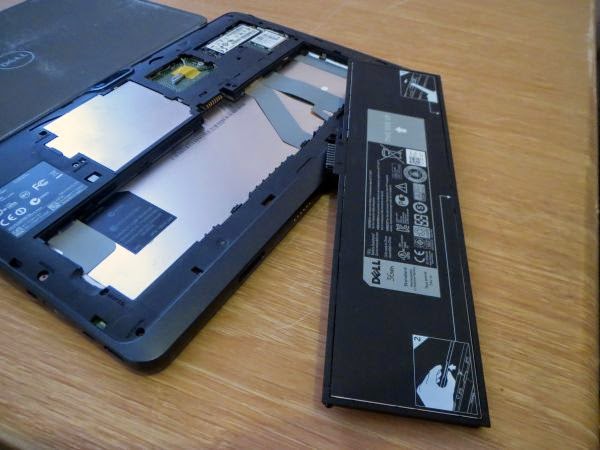Dell's latest 10.8" Windows tablet gets a newly designed fanless Core M system. The performance of these Core M processors are very competitive against the Y-series Haswells of previous generation, even though their thermals are 4.5W TDP vs. 11.5W TDP of Y-series Haswells. This is indeed a great achievement by Intel. It enables Dell to remove the fan from previous generation Venue 11 Pro.
 |
| Dell Venue 11 Pro 7140 (Core M) |
On the back of the tablet there appears a removable back panel. But wait, how to get this thing off?
 |
| Back side |
 |
| Docking keyboard and touchpad with 20Wh secondary battery |
Dell offers a docking keyboard to convert the tablet into a laptop. This keyboard contains a 20Wh secondary battery that extends running time, while also balancing the laptop so it does not tip over.
 |
| Dual-monitor desktop replacement! Hmm... |
Dell also offers desktop docking solutions with dual display and ethernet, which enables the tablet to become a desktop replacement solution. The Core M excels here and I think a lot of users especially the office desks could potentially lose the old-time desktop PC! The future of desktop ATX form factor has just become even more bleak.
| Docking ports and latch |
| Micro USB charging, micro HDMI and USB 3.0 |
| Micro SD slot, power button |
There is a screw hiding somewhere to defeat our attempt to release the back panel.
 |
| Dell's inner beauty. Do you see the clip ports along the edges? That's where you need to pryyyyy! |
There are about 18 or so clips along the edges of the back panel. One would need a little help from some plastic prying tool to gently release these clips one by one, before the back panel can be set free.
Did we mention this beauty is fanless? The large copper heatsink in the picture tells the story. It would give you zero noise and keep the inside clean as its first day.
Did we mention this beauty is fanless? The large copper heatsink in the picture tells the story. It would give you zero noise and keep the inside clean as its first day.
From the picture the serviceable components are the battery, SSD (M.2), wireless LAN (wifi), wireless WAN (4G). This type of maintenance is typically not considered for average users, but it does look like Venue 11 Pro 7140 is among the easier tablets, allowing a significant number of users to replace battery or upgrade SSD on their own.
We rather like the user removable battery in the previous model 7130 a lot. That elder brother has a 36Wh battery than the 38Wh battery equipped with 7140, and 7140 is 10.75mm thick vs. 12.2mm with 7130. It's not clear how much importance having a non user-removable battery plays into the space savings, I would think it's more due to design improvements in many different things. But even if that's the only factor in play, we would still rather have a user-removable battery than a slightly thinner design. This is because it extends service life of the product thus reducing cost of ownership, by having a longer useful life or a better resale value. The 7140 most definitely loses some points in the serviceability aspect here.
 |
| User-removable battery in older model 7130: Nostalgia from a bygone era? |
The top spec'ed model has 8GB soldered RAM and 256GB SSD. 8GB RAM should be sufficient for most users in the next couple years.
Bottom line:
Fanless 10.8" ultraportable convertible tablet/laptop. Dell is back to its finest with a vengeance.
Score Card:
Upgradability: 6/10
Serviceability: 7/10
Connnectivity: 8/10
Portability: 9/10
Earth Spirit: 7/10
Expected service life: 5 years
















